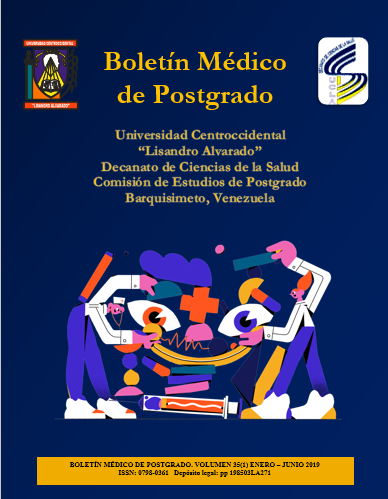Etiology of valvular heart disease. Centro Cardiovascular Regional ASCARDIO-Barquisimeto
Keywords:
cardiac valvular disease, stenosis, insufficiency, congenital, functionalAbstract
Valvular heart disease represents a public health problem worldwide. The goal of this study was to determine the etiology of valvular disease in patients that attend the cardiac valvular pathology consult of the Centro Cardiovascular Regional ASCARDIO-Barquisimeto during the period 2002 to 2015. We reviewed 1760 medical charts and the results show that mitral regurgitation was the most frequent lesion (66.13%). In regards to aortic valvular pathology, severe aortic stenosis predominated in 69.2% of cases followed by mild aortic regurgitation (37.7%). The main cause was degenerative for both aortic stenosis and regurgitation (76.4% and 59.5%, respectively). With respect to mitral valve lesion, stenosis and severe regurgitation was more common (58.3%, and 42.4%, respectively), while the etiology of mitral stenosis and insufficiency was in most cases rheumatic. Tricuspid as well as pulmonary regurgitation was considered mainly functional. Pulmonary stenosis was exclusively congenital. This study provided information to evaluate the current situation of cardiac valvular disease in Lara state.
Downloads
References
2. Lung B, Vahanian A. Epidemiology of valvular heart disease in the adult. Nat Rev Cardiol 2011; 8(3): 162-72.
3. Lung B, Baron G, Butchart E, Delahaye F, Gohlke-Barwölf C, Levang O, et al. A prospective survey of patients with valvular heart disease in Europe: The Euro Heart Survey on Valvular Heart Disease. Eur Heart J 2003; 24(13): 1231-43.
4. Gómez-Doblas J, Peña J, Lozano C, Pinedo J, Chinchurreta P, Rubio A, et al. Registro Andaluz de Valvulopatías. Rev and Cardiología 2005.
5. Campos-Jordán N, Finizola V, Flores-Graterol Y, Rojas M, Martínez-Plaza J, Finizola-Celli B. Clínica de enfermedad valvular cardiaca del Centro Cardiovascular Regional ASCARDIO-Barquisimeto, estado Lara. Avances Cardiol 2008; 28(4): 240-244.
6. Ancona R, Comenale S. Mitral valve incompetence: epidemiology and causes. Eur Soc Cardiol 2018; 16(11).
7. Ancona R, Comenale S. Epidemiology of aortic valve stenosis (AS) and aortic valve incompetence (AI): is the prevalence of AS/AI similar in different parts of the world? Eur Soc Cardiol 2020; 18(10).
8. Andell P, Li X, Martisson A, Andersson C, Stagmo M, Zöller B, et al. Epidemiology of valvular heart disease in a Swedish nationwide hospital-based register study. Heart 2017; 103(21): 1696-1703.
9. Taramasso M, Alessandrini H, Latib A, Asami M, Attinger-Toller A, Biasco L, et al. Outcomes After Current Transcatheter Tricuspid Valve Intervention: Mid-Term Results From the International TriValve Registry. JACC Cardiovasc Interv 2019; 12(2): 155-165.
10. Zühlke L, Karthikeyan G, Engel M, Rangarajan S, Mackie P, Cupido-Katya Mauff B, et al. Clinical Outcomes in 3343 Children and Adults With Rheumatic Heart Disease From 14 Low- and Middle-Income Countries: Two-Year Follow-Up of the Global Rheumatic Heart Disease Registry (the REMEDY Study). Circulation 2016; 134(19):1456-1466.
Published
How to Cite
Issue
Section
Las opiniones expresadas por los autores no necesariamente reflejan la postura del editor de la publicación ni de la UCLA. Se autoriza la reproducción total o parcial de los textos aquí publicados, siempre y cuando se cite la fuente completa y la dirección electrónica de esta revista. Los autores(as) tienen el derecho de utilizar sus artículos para cualquier propósito siempre y cuando se realice sin fines de lucro. Los autores(as) pueden publicar en internet o cualquier otro medio la versión final aprobada de su trabajo, luego que esta ha sido publicada en esta revista.



